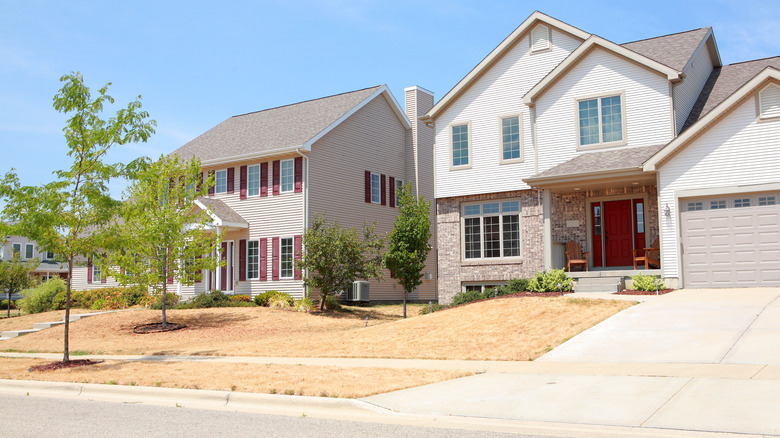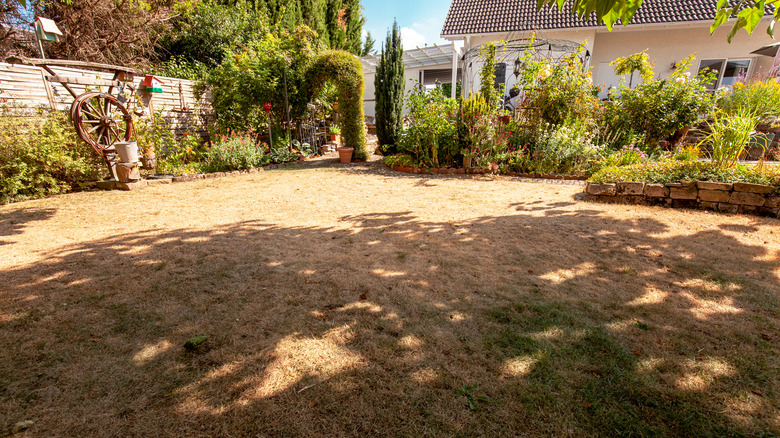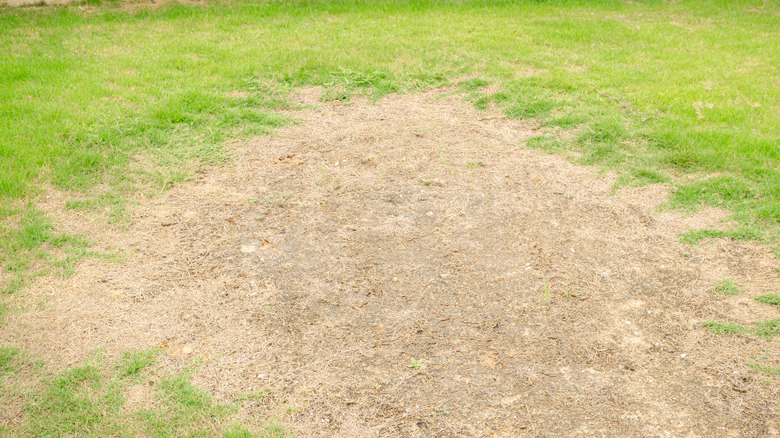Why Your Grass Goes Brown In The Summer (And Why You Shouldn't Panic About It)
Does your lawn shed its rich green color in the summer, adopting a dead and brown look? This unsightly transformation can cause alarm and drive you to look for causes. But in most cases, a brown summer lawn is completely natural. The grass is not dead; it's simply dormant.
There are two broadly categorized types of grasses grown in the United States. Cool-season grasses, like fescue or Kentucky bluegrass, generally flourish and exhibit their peak color in the spring and fall, with little growth happening over the summer. In contrast, warm-season grasses, such as Bahia grass or St. Augustine, look their best during the summer, when the weather is hot and humid. If you've got a cool-season lawn, it's perfectly normal for the turf to not only stop growing but also go dormant completely as it faces intense summer heat and a lack of moisture. This dormancy is not dangerous for the grass. As long as you give it the occasional watering and mow it regularly, it will exit dormancy and assume its green color once again come fall. Below, we explain how to care for your dormant lawn during the summer months — and when brown spots are cause for concern.
How to care for cool-season grass in the summer
As cool-season lawns turn brown and become dormant in the summer, remember that once it's turned brown, no amount of irrigation will return the grass to the same lush, verdant appearance it had in the spring. The green color will only return once fall comes around, cools the temperatures, and rain gives the lawn one soaking after another.
To avoid brown grass in the first place, you can water your lawn consistently before the heat and lack of moisture push it into dormancy. As a rule of thumb, a cool-season lawn needs to get an inch of water weekly to avoid going dormant. If rainfall does not satisfy this requirement, you'll need to irrigate. Watering once per week to about a half-foot depth is a better strategy than sprinkling the lawn a bit every day. When you water, be sure to do so early in the morning — irrigating the grass later in the day can encourage the spread of diseases.
Now, as extreme weather events become more frequent and intense, some local authorities impose water restrictions during the summer, especially in drought-stricken regions. These restrictions may limit when and how often you can water the lawn. In several places, lawn watering may be outright prohibited for some time. In these cases (or if you just want to conserve water without being told to), take the easy route and let the lawn sit dormant until fall.
When to worry about a lawn that looks brown
At times, your lawn may turn brown for reasons other than seasonal weather changes. These causes can be more sinister, and you should be proactive to keep the lawn healthy. For one, some locations may exacerbate the effects of heat and drought and kill the grass instead of driving it to dormancy. These include sloped areas that face the South or West. These areas not only get the maximum sun exposure, they also enable water runoff, which reduces the nurturing effects of irrigation. If parts of your lawn are sloped and oriented along the sun's path, consider using slow-drip watering methods to avert runoff and learn more about gardening on a slope. Also, learn how to tell dormant grass from dead grass so you know when there's a problem on your hands. Dormant grass should feel firm to the touch, and the turf should spring back when you press against it. Meanwhile, dead grass is easy to pull from the soil because its roots no longer work.
Another issue that can lead to brown grass is over-fertilization. Feeding the turf too much nitrogen inhibits root growth, and this condition will eventually manifest as brown patches on the lawn. If you notice that the grass is thinning out, it could be a tell-tale sign that your lawn is getting too much shade. If this is the case, you should consider planting grass that's more suitable for a lawn in a shady backyard.


